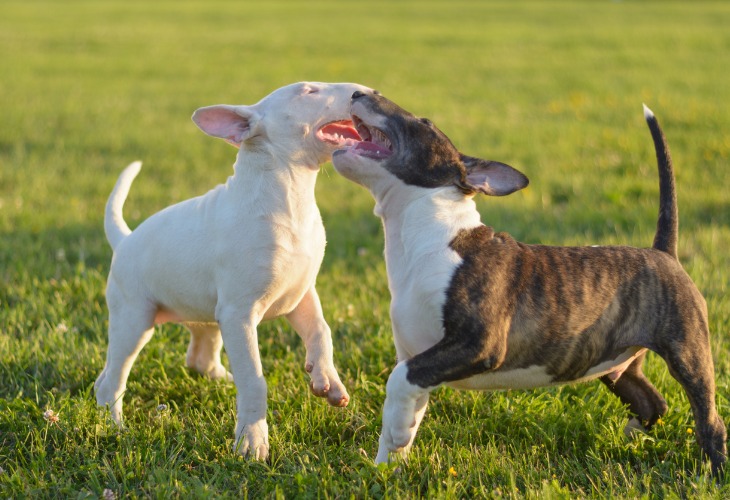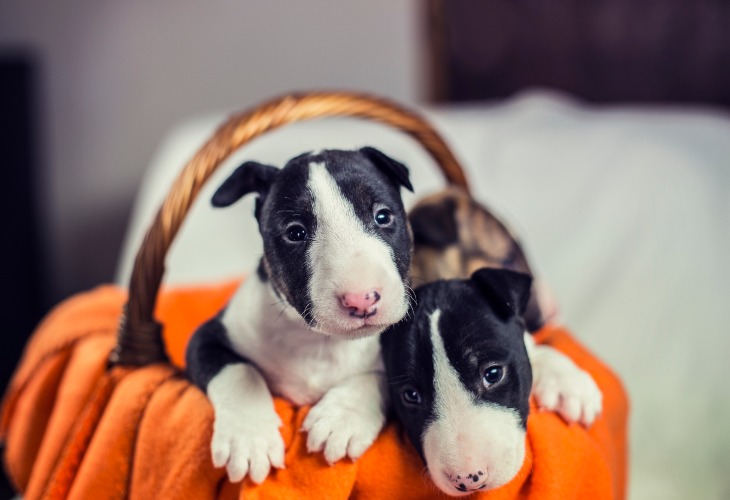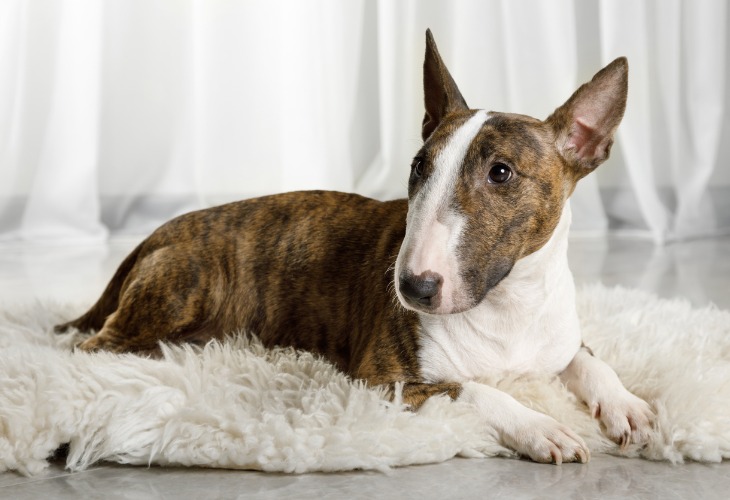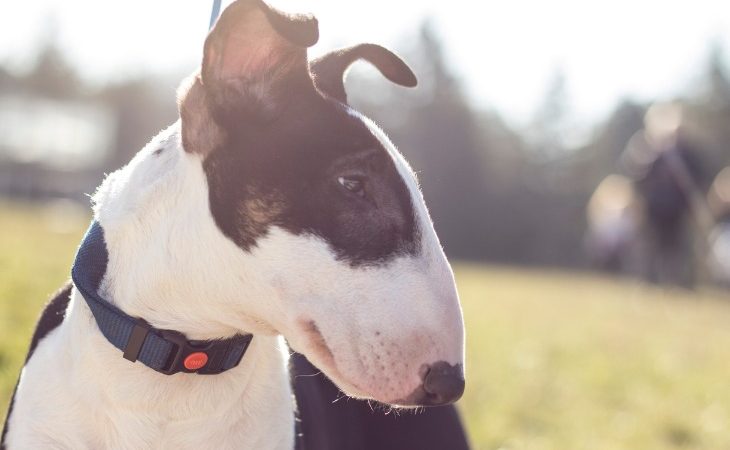Breed standard: The Kennel Club, FCI I Size: Medium I Average lifespan: 12+ years I Personality: Independent, stubborn, brave, and lively I Coat: Short I Origin: England.
The Bull Terrier is a brave, lively, and clever dog.
The origins of the Bull Terrier
Bulldog + Terrier = Bull Terrier
To begin with, in the early 19th century, “Bull and Terrier” breeds were created in England. They were created by crossing English Bulldogs and White English Terriers. White English Terrier were sighthound hunting dogs, which is now an instinct dog breed.
These early crosses gave rise to the White Cavalier, the ancestor of the this breed. The White Cavalier did not yet possess the breed’s characteristic skull shape. In order to perfect its physical appearance, the White Cavalier was crossed with the Dalmatian, the English Greyhound, the Spanish Pointer, the Foxhound and the Whippet in order to improve its elegance and agility. Later on, they were also crossed with the Borzoi and the Collie in order to reduce the stop of their muzzle and them the particular shape of their skull.
At the origin of all these crosses is a man named James Hinks. He bred the dog with a specific goal in mind, obtaining a Bull Terrier with a white coat. Very quickly, the various breedings caused several health problems known to affect the all-white dogs. For example, one of these health problems was deafness. Ted Lyon decided very quickly to add color to the dog’s coat by crossing the Bull Terriers with Staffordshire Bull Terriers at the end of the 20th century. The colored Bull Terriers were recognized as a separate variety in 1936.
Combat and recognition
Originally, the Bull Terrier was bred to control vermin. However, it quickly became a fighting dog. The breed stands out for its speed, its dexterity due to its light build and its strong endurance that it inherited from the Bulldog. However, in 1835, the British Parliament banned fighting between animals. This marked the beginning of the decline of the Bull Terrier breed. That year, clandestine fights between dogs emerged more and more and contributed to the official recognition of the breed in England. In France, the breed was officially recognized in 1943.

The Bull Terrier’s personality
There are two types of Bull Terriers, the Miniature Bull Terrier and the standard Bull Terrier. The Miniature Bull Terrier has the same personality attributes as the standard one.
Qualities
While the Bull Terrier is full of energy, it is a rather calm dog. They also listen when they are given commands. These dogs are often described as brave, witty, loving, and lively. It is an extremely intelligent and affectionate dog, especially with children. Socialization at an early age will allow this dog breed to develop a good relationship with other animals as well. As this dog breed is very brave and trustworthy, they make great guard dog.
In 2008, a German study showed that the personality of the Bull Terrier was quite similar to the Golden Retriever.
The Bull Terrier has similar needs to other dog breeds. It’s important to make sure that your dog gets enough exercise, play time, and affection on a daily basis.
Are there any downsides to having a Bull Terrier?
The Bull Terrier is independent and stubborn by nature. This dog is not ideal for people who have no experience training dogs.
Similar to other dog breeds, this dog could become destructive, depressed, unpredictable, or bark a lot if its needs are not met.
Living with a Bull Terrier
Whether in the city or in the country, this breed appreciates walks with its owner and does not thrive while being confined to a garden, regardless of its size.
If you live in an apartment, your Bull Terrier will need a daily walk of at least one hour, plus two more short walks during the day. To keep your dog healthy and fit, you can also do sports with him. It’s also important to avoid disturbing this breed while it is asleep so that they can balance.

The physical characteristics of the Bull Terrier
General
This dog has unique and beautiful physical features. Their body is solidly built, muscular, active and agile. This breed has great strength for the size that it is. Its structure is symmetrical and its expression is determined. When it comes to their movements, they are clear and powerful.
Head
This breed’s head is long and strong. Seen from the front, it forms an oval. The upper part of the skull is almost flat from ear to ear. When looking at its profile, it is slightly curved downward from the top of the skull to the nose. It has no stop. Its nose is black and sloping downwards at the end. The nostrils are well-developed.
This dog’s lower jaw is strong and thick. Its teeth are healthy, sharp, strong, of good size, and perfectly set.
The eyes of the Bull Terrier are narrow and triangular. They are well sunken in the orbits and of black or brown color. They have a piercing glare.
The ears are small, thin, and close together. They are straight and erect.
Body
The neck of this breed is very muscular, long with a curved upper profile. It is wide at the shoulders and it tapers to the base of the skull.
Its back is short and strong. Regarding the chest, it is high, well-rounded with curved ribs. The belly is well-raised. Its shoulders are strong and muscular without being loaded. The elbows are well against the body. This breed’s shoulder blades are wide and well-attached to the chest wall.
The thighs of this dog are muscular and the legs, well-developed. This breed’s paws are round and compact. The toes are well-arched.
Lastly, the tail is short, set low and carried horizontally. It is thick at the base and tapers to a fine point.
Health
The Bull Terrier has been the subject of numerous crosses, which have made the breed vulnerable to hereditary diseases. For the most part, the white Bull Terriers are subject to genetic defects.
Hearing problems
20.4% of white Bull Terriers have hearing loss problems compared to 1.3% of colored Bull Terriers. If you are interested in adopting a white Bull Terrier, it is recommended that you have a BAER test done to detect any possible deficiency.
Skin problems
White Bull Terriers are also more prone to skin problems. They can be sensitive to allergies related to insects stings from insects such as flies, mosquitoes, wasps, bees, etc. They are also more easily affected by skin issues such as demodecia or atopic dermatitis.
Other health issues
Other health problems are known to affect all types of Bull Terriers, regardless of color.
For example, joint problems are usually detected by simple palpation. In addition, heart and kidney problems are detected by ultrasound.
The Miniature Bull Terrier is generally affected by an autosomal recessive disease, lens luxation. It affects the dog’s eyesight and causes blindness around the age of nine.
To prevent genetic diseases, it is recommended to have your dog examined by your veterinarian regularly and from an early age.

Coat, color, and grooming
Coat
To begin with, the Bull Terrier’s coat is made up of short, flat, plain, rough, and slightly shiny hairs. In winter, a soft undercoat may be present.
Color
When it comes to the Bull Terrier’s color, it can be brindle, red, tan, white, black, or blue and can be mixed with white.
This type of coat is often seen with tan spots on the head and legs. The Bull Terrier can have merle, blue or red colors.
Grooming a Bull Terrier
The short coat makes this dog particularly easy to groom. During shedding season, rubbing a simple glove on its coat will allow you to get rid of dead hairs. You can also give this dog breed a bath from time to time.
Did you know?
The Bull Terrier is one of the most loyal and affectionate dog breeds.
The Bull Terrier at a glance
Size: 35 to 60 cm (≈ 13.7 to 23.6 in) at the withers.
Weight: 20 to 40 kg (≈ 44 to 88.1 lbs).
Average lifespan: 10 to 15 years.
Is the Bull Terrier good with children? This breed can sometimes be a bit brusque and doesn’t always know its strength. With that being said, it is an excellent companion for children, especially if they have known each other since the dog was young.
Is this dog breed easy to train? It is an intelligent, affectionate, and trustworthy dog. This breed understands commands easily and does them with pleasure. However, it can also be a bit stubborn sometimes.

